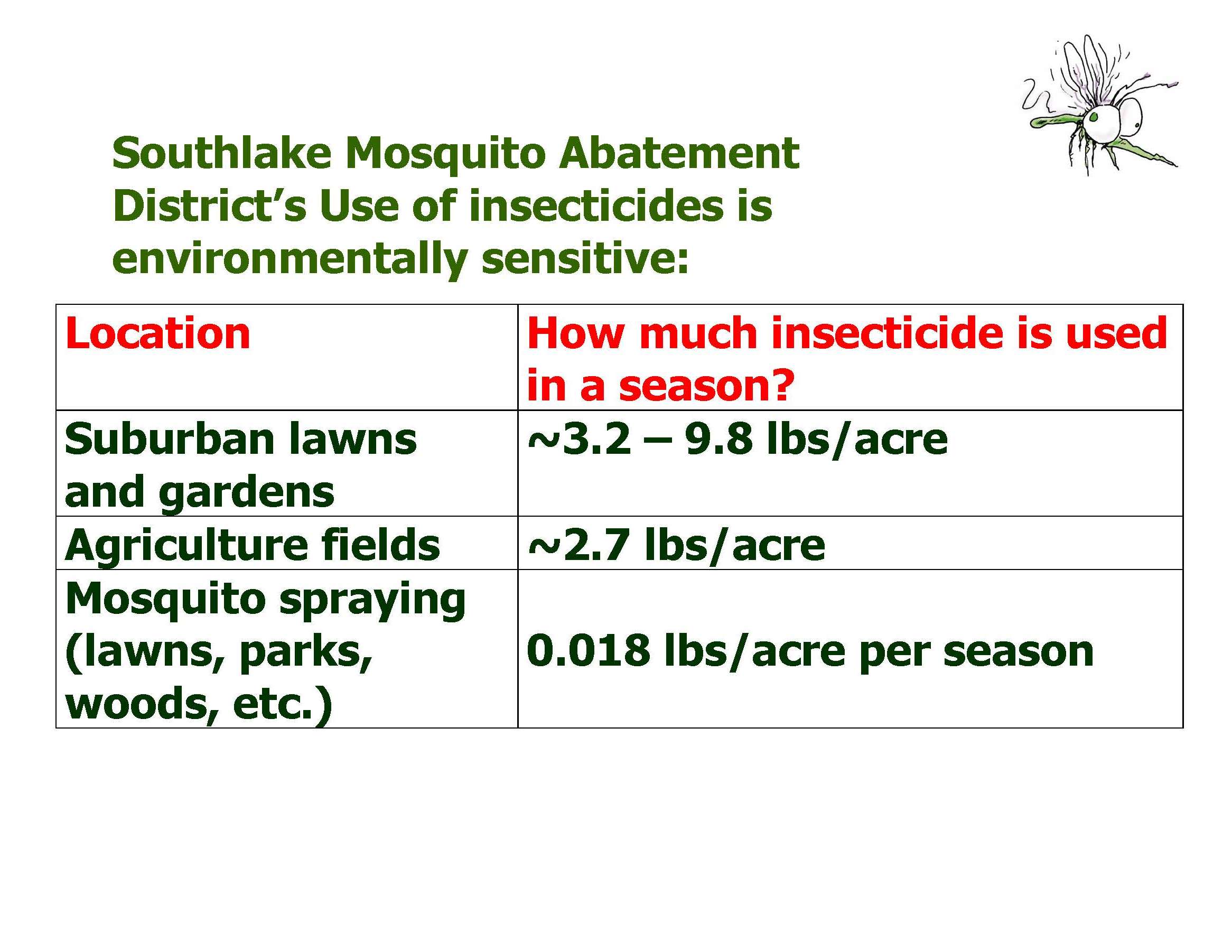Resources
Florida Mosquitoes: 750 million genetically modified insects to be released
News Release - Illinois EPA completes Forced Removal Action at Patriot Tire Shredders
South Lake Mosquito Abatement Brochure
Zika Brochure - English Download
Zika Brochure - Spanish Download

Vital Signs: Zika-Associated Birth Defects and Neurodevelopmental Abnormalities Possibly Associated with Congenital Zika Virus Infection — U.S. Territories and Freely Associated States, 2018 - CDC
Abstract
Introduction: Zika virus infection during pregnancy causes serious birth defects and might be associated with neurodevelopmental abnormalities in children. Early identification of and intervention for neurodevelopmental problems can improve cognitive, social, and behavioral functioning.
Methods: Pregnancies with laboratory evidence of confirmed or possible Zika virus infection and infants resulting from these pregnancies are included in the U.S. Zika Pregnancy and Infant Registry (USZPIR) and followed through active surveillance methods. This report includes data on children aged ≥1 year born in U.S. territories and freely associated states. Receipt of reported follow-up care was assessed, and data were reviewed to identify Zika-associated birth defects and neurodevelopmental abnormalities possibly associated with congenital Zika virus infection.
Results: Among 1,450 children of mothers with laboratory evidence of confirmed or possible Zika virus infection during pregnancy and with reported follow-up care, 76% had developmental screening or evaluation, 60% had postnatal neuroimaging, 48% had automated auditory brainstem response-based hearing screen or evaluation, and 36% had an ophthalmologic evaluation. Among evaluated children, 6% had at least one Zika-associated birth defect identified, 9% had at least one neurodevelopmental abnormality possibly associated with congenital Zika virus infection identified, and 1% had both.
Conclusion: One in seven evaluated children had a Zika-associated birth defect, a neurodevelopmental abnormality possibly associated with congenital Zika virus infection, or both reported to the USZPIR. Given that most children did not have evidence of all recommended evaluations, additional anomalies might not have been identified. Careful monitoring and evaluation of children born to mothers with evidence of Zika virus infection during pregnancy is essential for ensuring early detection of possible disabilities and early referral to intervention services. - More
New Mosquito-borne Virus Now in Louisiana - Fox8Live.com
Baton Rouge, LA (WVUE) - A new mosquito-borne virus has made its way to Louisiana. Chikungunya fever, which has been recognized in Asia and Africa for more than 60 years, was seen for the first time in the Western Hemisphere last December when it showed up in the caribbean, said LSU AgCenter entomologist Kirsten Healy. "We know of eight cases of chikungunya fever so far in the state of Louisiana, Healy said. "There has been one case in Grant Parish, three cases in Jefferson, three in Orleans and one in Tangipahoa." - More
Mosquito-borne diseases has threaten World EveryGoodNews.com
Mosquitoes are considered one of the most dangerous creatures on the planet because of their ability to spread deadly diseases.
The U.S. Centers for Disease Control report that the insects kill more than one million people a year just through the transmission of malaria. Add to that the numbers of those sickened and killed by other mosquito-borne diseases such as dengue fever, yellow fever and West Nile virus, and it’s easy to see how they earned their dangerous reputation. In recent years the rate of infection has risen dramatically, and a growing number of scientists are now concerned that global warming will translate into an explosive growth of mosquito-borne diseases worldwide.
These are some of the most prevalent diseases spread around the world by mosquito bites: -
Changes in Seroprevalence of West Nile Virus across Illinois in Free-Ranging Birds from 2001 through 2004 By Tara A. Beveroth, Michael P. Ward, Richard L. Lampman, Adam M. Ringia and Robert J Novak - from the American Society of Tropical Medicine and Hygiene Abstract. Of the 5,236 birds sampled for antibodies to West Nile (WNV) in Illinois from 2001 through 2004, 348 (6.6%) birds were seropositive. Our multiple year surveillance identified several avian species that had particularly high percentages of seropositive individuals. The importance of these species in the enzootic and/or epizootic transmission of WNV is discussed relative to their regional abundance and literature on host competency. - read more What’s the Problem? Mosquitoes are true pests, a source of immense suffering due to the diseases they spread to humans and animals. They are annoying, biting insects that spread disease pathogens from one host to another. Several viruses and parasites can be carried by mosquitoes. Yellow Fever - Once Again on the Radar Screen in the Americas - The New England Journal of Medicine Four arthropod-borne (arboviruses) have recently emerged or reemerged in the Americas, spreading rapidly through populations that had not previously been exposed to them and causing substantial morbidity and mortality. The first was dengue, which reemerged to cause widespread disease predominantly in South America and the Caribbean in the 1990s. This edpidemic was followed by West Nile viruse in 1999, which has since become endemic in the continental United States, and chikungunya in 2013, which continues to cause disease, predominantly in the Caribbean and South America - Read more Zika Virus as a Cause of Neurologic Disorders - The New England Journal of Medicine Mosquito Repellents are Tested for Safety by EPA - Mosquitoes Aren't - printable flyer
Zika virus infections have been know in Africa and Asia since the 1940", but the virus's geographic range has expanded dramatically since 2007. Between January 1, 2007 and March 1, 2016 local tranmission was reported in an additional 52 countries and territories, mainly in the Americas and the western Pacific, but also in Africa and southeast Asia. - Read more
Efficacy of SomeWearable Devices Compared with Spray-On Insect Repellents for the Yellow Fever
Mosquito, Aedes aegypti (L.) (Diptera: Culicidae)
Stacy D. Rodriguez,1,2 Hae-Na Chung,1 Kristina K. Gonzales,1 Julia Vulcan,1 Yiyi Li,4 Jorge A. Ahumada,3 Hector M. Romero,3 Mario De La Torre,3 Fangjun Shu,3 and Immo A. Hansen1,5
1Department of Biology, New Mexico State University, 1200 S. Horseshoe Dr, Las Cruces, NM 88003, 2Corresponding author, e-mail: stacyr@nmsu.edu, 3Mechanical and Aerospace Engineering, New Mexico State University, 1040 S. Horseshoe Dr, Las Cruces, NM 88003, 4Department of Computer Science, New Mexico State University, 1290 Frenger Mall, Las Cruces, NM 88003, and 5Institute of Applied Biosciences, New Mexico State University, 1200 S. Horseshoe Dr, Las Cruces, NM 88003 Subject Editor: Nannan Liu Received 26 August 2016; Editorial decision 27 November 2016 Abstract The current Zika health crisis in the Americas has created an inte nse interest in mosquito control methods and products. Mosquito vectors of Zika are of the genus Aedes, mainly the yellow fever mosquito, Aedes aegypti. L. The use of repellents to alter mosquito host seeking behavior is an effective method for the prevention of
mosquito-borne diseases. A large number of different spray-on repellents and wearable repellent devices are commercially available. The efficacies of many repellents are unknown. This study focuses on the efficacy of eleven different repellents in reducing the number of Ae. aegypti female mosquitoes attracted to human bait. We performed attraction-inhibition assays using a taxis cage in a wind tunnel setting. - read more


